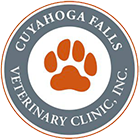Dogs and cats present with all types of diseases and conditions every week here at the Cuyahoga Falls Veterinary Clinic, and while many of these are routine to one degree or another and somewhat easily diagnosed, we get thrown some real curveballs.
This is a story of one such curveball that has shown that when we’re able to stick with a case, and work though the variables, we can achieve good success and great quality of life.
Didi is a kitty that showed up on her owners’ doorstep very young and in very poor condition. It wasn’t long after she got some good nutrition and started to develop physically that she began itching at her face and neck in the most aggressive of ways.
At first it appeared to be some sort of allergy. Didi wasn’t exactly a team player with a food trial, and that made things a little more difficult. She visited a local board certified veterinary dermatologist where she underwent allergy testing, but nothing significant came up. Based on the lack of results, she’d been given a variety of symptomatic treatments that didn’t seem to make much of a difference with her scratching behavior.
Things came to a head in January when her scratching became so aggressive that she was making herself bleed. Declawing her hind paws had been declined in the past, but her owners decided that she needed to have her “weapons” taken away while the underlying cause was still under investigation.
At this presentation, we found her neck in this condition:
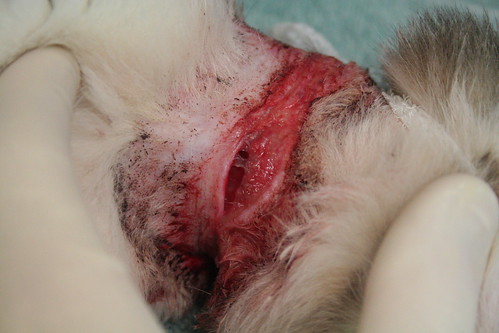 |
Didi needed her neck wounds closed in addition to the scheduled declaw.
At the time of surgery, Didi was given a preanesthetic combination of sedatives and pain medications and she was taken to general anesthesia uneventfully. The laser declaw portion of the procedure went off without a hitch. Didi’s heartrate maintained between 110 and 120 beats per minute. After completing the declaw, I proceeded to place sutures in the skin around her neck, and when I touched the skin with my thumb forceps, her heartrate jumped to 180 beats per minute. Even under general anesthesia, sufficient anesthesia that she was pain-free during the declaw, her body was aware of the sensory stimulation around her neck. New insight!
In addition to the post-operative pain management that is standard with our declaw patients, we started her on treatment for hypresthesia/hypersenstivity, and when she came in for suture removal, her owners were thrilled!
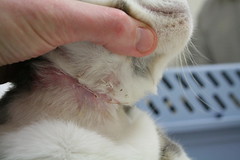 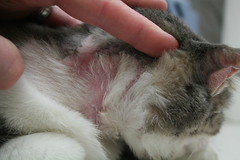 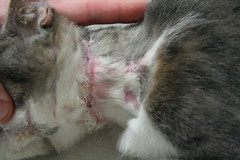 |
She’s running around comfortably, and she’s getting back to the type of lifestyle that she’d missed out on by focusing so much on her skin and neurologic situation.
Is this case typical? No. But it illustrates how some off-the-wall cases require more work-up and attention than others, and when we’re able to see them through, patients with these tough cases can experience a dramatic improvement in their quality of life.

